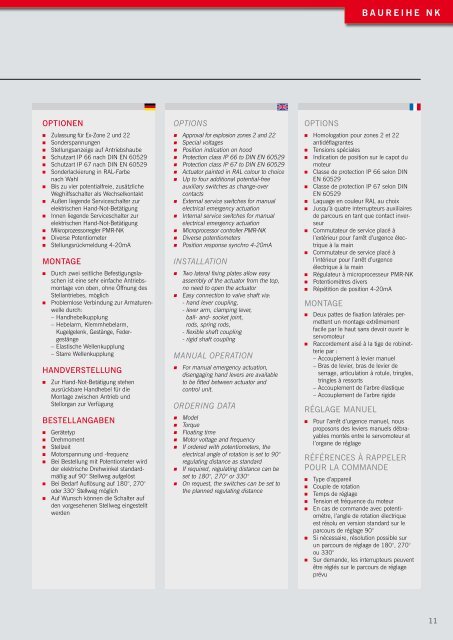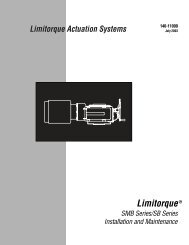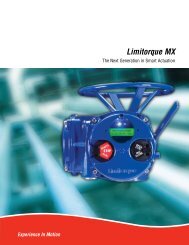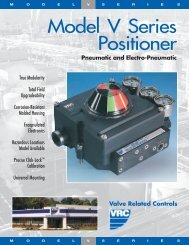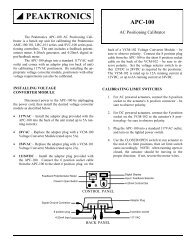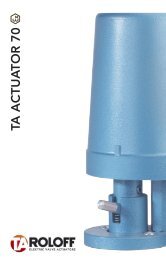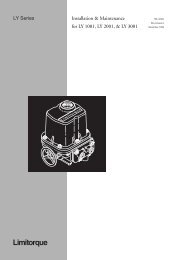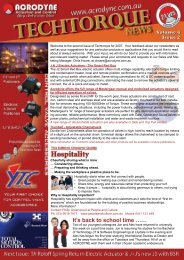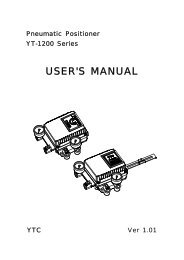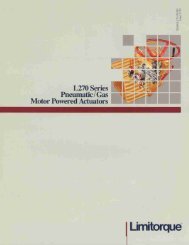A R I S A n t r i e b e u n d S t e u e r u n g e n G m b H
ARIS Antriebe und Steuerungen GmbH - Acrodyne
ARIS Antriebe und Steuerungen GmbH - Acrodyne
- No tags were found...
Create successful ePaper yourself
Turn your PDF publications into a flip-book with our unique Google optimized e-Paper software.
B a u r e i h e N KOptionenn Zulassung für Ex-Zone 2 und 22n Sonderspannungenn Stellungsanzeige auf Antriebshauben Schutzart IP 66 nach DIN EN 60529n Schutzart IP 67 nach DIN EN 60529n Sonderlackierung in RAL-Farbenach Wahln Bis zu vier potentialfreie, zusätzlicheWeghilfsschalter als Wechselkontaktn Außen liegende Serviceschalter zurelektrischen Hand-Not-Betätigungn Innen liegende Serviceschalter zurelektrischen Hand-Not-Betätigungn Mikroprozessorregler PMR-NKn Diverse Potentiometern Stellungsrückmeldung 4-20mAMontagen Durch zwei seitliche Befestigungslaschenist eine sehr einfache Antriebsmontagevon oben, ohne Öffnung desStellantriebes, möglichn Problemlose Verbindung zur Armaturenwelledurch:– Handhebelkupplung– Hebelarm, Klemmhebelarm,Kugelgelenk, Gestänge, Federgestänge– Elastische Wellenkupplung– Starre WellenkupplungHandverstellungn Zur Hand-Not-Betätigung stehenausrückbare Handhebel für dieMontage zwischen Antrieb undStellorgan zur VerfügungBestellangabenn Gerätetypn Drehmomentn Stellzeitn Motorspannung und -frequenzn Bei Bestellung mit Potentiometer wirdder elektrische Drehwinkel standardmäßigauf 90° Stellweg aufgelöstn Bei Bedarf Auflösung auf 180°, 270°oder 330° Stellweg möglichn Auf Wunsch können die Schalter aufden vorgesehenen Stellweg eingestelltwerdenOPTIONSn Approval for explosion zones 2 and 22n Special voltagesn Position indication on hoodn Protection class IP 66 to DIN EN 60529n Protection class IP 67 to DIN EN 60529n Actuator painted in RAL colour to choicen Up to four additional potential-freeauxiliary switches as change-overcontactsn External service switches for manualelectrical emergency actuationn Internal service switches for manualelectrical emergency actuationn Microprocessor controller PMR-NKn Diverse potentiometersn Position response synchro 4-20mAINSTALLATIONn Two lateral fixing plates allow easyassembly of the actuator from the top,no need to open the actuatorn Easy connection to valve shaft via:- hand lever coupling,- lever arm, clamping lever,ball- and- socket joint,rods, spring rods,- flexible shaft coupling- rigid shaft couplingMANUAL OPERATIONn For manual emergency actuation,disengaging hand levers are availableto be fitted between actuator andcontrol unit.ORDERING DATAn Modeln Torquen Floating timen Motor voltage and frequencyn If ordered with potentiometers, theelectrical angle of rotation is set to 90°regulating distance as standardn If required, regulating distance can beset to 180°, 270° or 330°n On request, the switches can be set tothe planned regulating distanceOPTIONSn Homologation pour zones 2 et 22antidéflagrantesn Tensions spécialesn Indication de position sur le capot dumoteurn Classe de protection IP 66 selon DINEN 60529n Classe de protection IP 67 selon DINEN 60529n Laquage en couleur RAL au choixn Jusqu’à quatre interrupteurs auxiliairesde parcours en tant que contact inverseurn Commutateur de service placé àl’extérieur pour l’arrêt d’urgence électriqueà la mainn Commutateur de service placé àl’intérieur pour l’arrêt d’urgenceélectrique à la mainn Régulateur à microprocesseur PMR-NKn Potentiomètres diversn Répétition de position 4-20mAMontagen Deux pattes de fixation latérales permettentun montage extrêmementfacile par le haut sans devoir ouvrir leservomoteurn Raccordement aisé à la tige de robinetteriepar :– Accouplement à levier manuel– Bras de levier, bras de levier deserrage, articulation à rotule, tringles,tringles à ressorts– Accouplement de l’arbre élastique– Accouplement de l’arbre rigideRÉGLAGE MANUELn Pour l’arrêt d’urgence manuel, nousproposons des leviers manuels débrayablesmontés entre le servomoteur etl’organe de réglageRÉFÉRENCES À RAPPELERPOUR LA COMMANDEn Type d’appareiln Couple de rotationn Temps de réglagen Tension et fréquence du moteurn En cas de commande avec potentiomètre,l’angle de rotation électriqueest résolu en version standard sur leparcours de réglage 90°n Si nécessaire, résolution possible surun parcours de réglage de 180°, 270°ou 330°n Sur demande, les interrupteurs peuventêtre réglés sur le parcours de réglageprévu11


